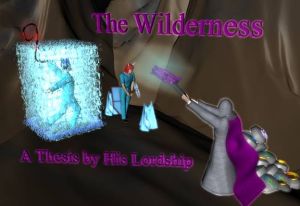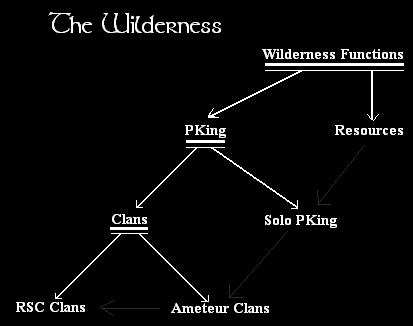Difference between revisions of "Wilderness Thesis (2006)"
| Line 8: | Line 8: | ||
===Preface: Author's Comments=== | ===Preface: Author's Comments=== | ||
| + | |||
| + | <p>I am very pleased to present you with this work, which is a culmination of many varied opinions of the Runescape people. This work is available for your use and leisure at any time. You may copy parts of it or take it entirely, but if you do so, please give due credit and a link back to this website.</p> | ||
| + | |||
| + | <p>This document was not meant to offer advice. It is only an explanation of how things work. For example, pretend the wilderness is a clock. All this document does, is tell you how this clock works. It doesn’t tell you how to repair it, or how to keep it in top condition. In essence, this thesis is just a summary of all that which occurs inside the wilderness. However, it does not mean this document does not have practical uses. Having a greater understanding of the wilderness will undoubtedly advance your ability to exploit it.</p> | ||
| + | |||
| + | <p>If you have any queries in regard to my thesis, or changes to make, send me a personal email, at ''[email redacted]'' and ensure you specify whether or not you would like a reply.</p> | ||
===Introduction=== | ===Introduction=== | ||
| + | |||
| + | <p>There is no place in Runescape like the wilderness. It is the most dynamic and perpetual spread of land in the entire game. Players of all areas, from skills, to fighting, are drawn to it. It is quite safe to say, that the wilderness plays host to the most thrilling experience in Runescape.</p> | ||
| + | |||
| + | <p>Why?</p> | ||
| + | |||
| + | <p>Why is it that people feel safer walking through the Taverly Dungeon than browsing the wilderness? Why is it so less stressful to destroy a mighty dragon, than fight another player?</p> | ||
| + | |||
| + | <p>There is a human element. The human element creates chaos. Nothing is ever predictable. No fight will ever be the same, and no human is the same. This inability to predict an outcome is what thrills us. We fear that which we do not know. No amount of fights with the game’s fiercest creatures could ever compare.</p> | ||
| + | |||
| + | <p>This territory is mostly barren and uninteresting. In fact, it is the plainest setting on the map. Yet, out of this dead zone comes an intricate ballet of life, where the interplay of giants and dwarves plays on all the time. It can simultaneously accommodate a level three, fresh off tutorial island, to a large three hundred man clan, or a coal miner or explorer. And each of these groups has their own limits, and are bound together by the great chain of predation.</p> | ||
| + | |||
| + | <p>Indeed, the wilderness is more complicated than dressing up and walking out and tapping your sword against someone else’s flesh.</p> | ||
| + | |||
| + | <p>The thesis can be explained very simply with a diagram.</p> | ||
| + | |||
| + | [[File:Thesis Diagram.jpg]] | ||
| + | |||
| + | <p>In this thesis, we begin by looking at what happens on the surface level. We can agree that the wilderness is designed for PKing and for the gathering of resources. The PKing category is far more complex than the resource counterpart. So then, we must focus more on PKing, and in the second section, we can again divide PKing into two categories. Solo PKing (Teams fall under solo PKing for a reason later to be explained) and Clans. Solo PKing is, again, far less complex than the clan world, and so we devote another chapter to the world of clans. Yet STILL, the world of clans is far too complex to explain in a single chapter, so we divide the clan world into those amateur clans, and the clans belonging to Runescape Community. And so the next chapter hones in on the Runescape Community clans, in particular, the concept of honour. This concept is unique to these clans. While it is possible to delve into more detail on RSC Clans, such a move would be too difficult, as the clan world, more than the rest of the wilderness, is dictated by the human mind, and therefore evolves and expands and cannot be explained properly.</p> | ||
| + | |||
| + | <p>After all this, we bind them all together in the chapter of the chain of predation, indicated by the grey arrows. Skill players become targets for Solo PKers, which become targets for amateur clans, which are targets of the legendary RSC clans. And so, we see how all aspects, from skills, to PKing solo, to clans, are all linked by this great chain.</p> | ||
| + | |||
| + | <p>Finally, to finish our thesis, we compare the vastly different worlds of P2P and F2P and show how the whole system differs.</p> | ||
| + | |||
| + | <p>And so we seek, in this thesis, to try and explain the great ecosystem that exists within the game we all know and love. Where better to start, than on surface level. Let us explore the wilderness, in its most basic form.</p> | ||
===Functions of the Wilderness=== | ===Functions of the Wilderness=== | ||
Revision as of 22:44, 9 April 2025
- See also: Wilderness Thesis (2004)
The Wilderness Thesis is a document which comprehensively analyses the PvP clan community and practices within RuneScape around 2006. It was written by His Lordship and published to the Wilderness Guardians website sometime during or before June 2006[1], and supersedes the 2004 Thesis from two years previously. The full thesis is as follows, copied verbatim from the original apart from stylistic changes to fit the wiki format.
Contents
The Wilderness
Preface: Author's Comments
I am very pleased to present you with this work, which is a culmination of many varied opinions of the Runescape people. This work is available for your use and leisure at any time. You may copy parts of it or take it entirely, but if you do so, please give due credit and a link back to this website.
This document was not meant to offer advice. It is only an explanation of how things work. For example, pretend the wilderness is a clock. All this document does, is tell you how this clock works. It doesn’t tell you how to repair it, or how to keep it in top condition. In essence, this thesis is just a summary of all that which occurs inside the wilderness. However, it does not mean this document does not have practical uses. Having a greater understanding of the wilderness will undoubtedly advance your ability to exploit it.
If you have any queries in regard to my thesis, or changes to make, send me a personal email, at [email redacted] and ensure you specify whether or not you would like a reply.
Introduction
There is no place in Runescape like the wilderness. It is the most dynamic and perpetual spread of land in the entire game. Players of all areas, from skills, to fighting, are drawn to it. It is quite safe to say, that the wilderness plays host to the most thrilling experience in Runescape.
Why?
Why is it that people feel safer walking through the Taverly Dungeon than browsing the wilderness? Why is it so less stressful to destroy a mighty dragon, than fight another player?
There is a human element. The human element creates chaos. Nothing is ever predictable. No fight will ever be the same, and no human is the same. This inability to predict an outcome is what thrills us. We fear that which we do not know. No amount of fights with the game’s fiercest creatures could ever compare.
This territory is mostly barren and uninteresting. In fact, it is the plainest setting on the map. Yet, out of this dead zone comes an intricate ballet of life, where the interplay of giants and dwarves plays on all the time. It can simultaneously accommodate a level three, fresh off tutorial island, to a large three hundred man clan, or a coal miner or explorer. And each of these groups has their own limits, and are bound together by the great chain of predation.
Indeed, the wilderness is more complicated than dressing up and walking out and tapping your sword against someone else’s flesh.
The thesis can be explained very simply with a diagram.
In this thesis, we begin by looking at what happens on the surface level. We can agree that the wilderness is designed for PKing and for the gathering of resources. The PKing category is far more complex than the resource counterpart. So then, we must focus more on PKing, and in the second section, we can again divide PKing into two categories. Solo PKing (Teams fall under solo PKing for a reason later to be explained) and Clans. Solo PKing is, again, far less complex than the clan world, and so we devote another chapter to the world of clans. Yet STILL, the world of clans is far too complex to explain in a single chapter, so we divide the clan world into those amateur clans, and the clans belonging to Runescape Community. And so the next chapter hones in on the Runescape Community clans, in particular, the concept of honour. This concept is unique to these clans. While it is possible to delve into more detail on RSC Clans, such a move would be too difficult, as the clan world, more than the rest of the wilderness, is dictated by the human mind, and therefore evolves and expands and cannot be explained properly.
After all this, we bind them all together in the chapter of the chain of predation, indicated by the grey arrows. Skill players become targets for Solo PKers, which become targets for amateur clans, which are targets of the legendary RSC clans. And so, we see how all aspects, from skills, to PKing solo, to clans, are all linked by this great chain.
Finally, to finish our thesis, we compare the vastly different worlds of P2P and F2P and show how the whole system differs.
And so we seek, in this thesis, to try and explain the great ecosystem that exists within the game we all know and love. Where better to start, than on surface level. Let us explore the wilderness, in its most basic form.
Functions of the Wilderness
Resources
PKing
Clans
PK Trips
Wars
Runescape Community
Codes of Honour
Teleporting, Logging and Running
Crashing and PJing
AntiRPKing
Luring
Praying
Spying
Bad Equipment
The Chain of Predation
P2P vs. F2P Wilderness
Geography
Equipment
Distribution
Clan Wars
Conclusion
References
- ↑ The Wilderness, The Wilderness Guardians. Archived from the original on 28 June 2006, retrieved 9 April 2025.

